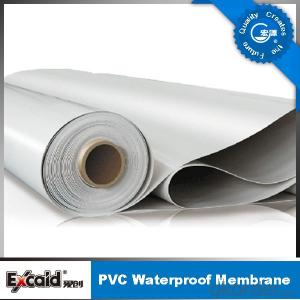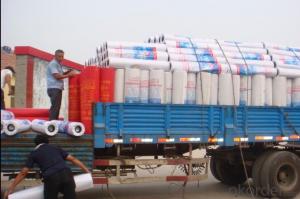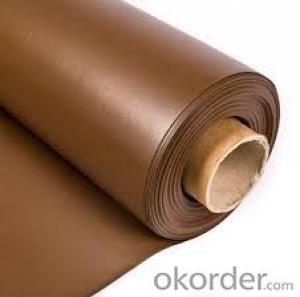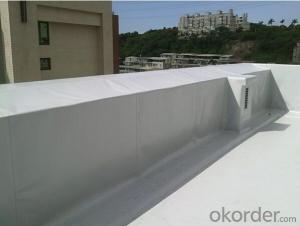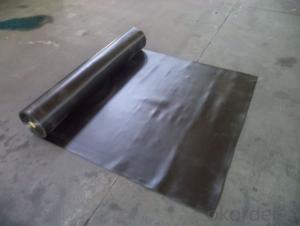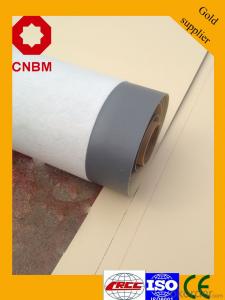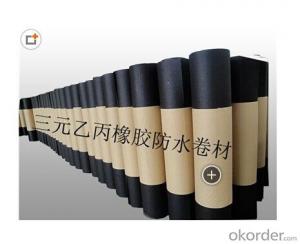PVC roofing and waterproofing membrane manufacturer
- Loading Port:
- Qingdao
- Payment Terms:
- TT OR LC
- Min Order Qty:
- 500 m²
- Supply Capability:
- 600000 m²/month
OKorder Service Pledge
OKorder Financial Service
You Might Also Like
PVC roofing and waterproofing membrane
1. Introduction
Polyvinyl Chloride (PVC) waterproof membrane is a new polymer waterproof membrane which is
made from polyvinyl chloride resin, and mixed with plasticizer, filler, antioxygen, ultraviolet
absorber and other auxiliaries.
2. Specification
1) Size: 2.05(width)*20m (length)
2) Thickness: 1.2mm; 1.5mm; 2.0mm
3) Type: Homogeneous, Reinforced, With fabric back
4) Exposed and Non-exposed
5) Color: white, Grey or customized
6) Certificate: ISO9001/14001
3. Applications
1) All kinds of roofs, such as steel structure roof, planted roof etc.
2) Underground engineering, such as basement, subways, tunnels, air raid shelter, etc.
3) Other projects like artificial lake, dam, water reservoir, grain storehouse, etc.
4. Features
1) Excellent aging resistance.
2) Root resistant penetration, specially used on planting roof.
3) Welding installation. Joints are solid and environment friendly, no pollution.
4) High tensile strength, good elongation and dimensional stability.
5) Good plasticity, easy and suitable for details installation.
6) Fireproof. Fire extinguished out of the ignition resource.
7) Surface is smooth, no fading and dirty resistant.
- Q: Can a waterproofing membrane be used in temporary or temporary structures?
- Indeed, temporary or transient structures can benefit from the utilization of a waterproofing membrane. These specialized membranes are crafted to establish a safeguard against the infiltration of water, a critical measure in thwarting any potential moisture-related harm in various architectural formations. Be it a fixed or impermanent construction, such as a provisional refuge, tent, or temporary worksite, the application of a waterproofing membrane guarantees the attainment of water resistance and protection. Consequently, it becomes imperative to meticulously select a waterproofing membrane that aligns with the distinct requisites of the temporary structure, while adhering to the appropriate installation protocols to ensure its utmost efficacy.
- Q: Are there different waterproofing membrane options for above-ground and below-ground applications?
- Yes, there are different waterproofing membrane options available for above-ground and below-ground applications. Above-ground applications typically involve waterproofing structures such as roofs, balconies, or walls. For these applications, commonly used waterproofing membrane options include liquid-applied membranes, sheet membranes, and polyurethane membranes. These membranes are designed to withstand exposure to weather elements such as UV rays, temperature changes, and foot traffic. On the other hand, below-ground applications involve waterproofing structures like basements, foundations, or tunnels. Below-ground waterproofing membranes are specifically designed to withstand hydrostatic pressure from the surrounding soil and groundwater. These membranes are typically thicker and more durable than above-ground membranes. Commonly used below-ground waterproofing options include bituminous membranes, bentonite clay membranes, and composite membranes. It is important to choose the right waterproofing membrane for each specific application as the requirements and challenges can vary. Consulting with a waterproofing professional or engineer can help determine the most suitable membrane option for both above-ground and below-ground applications.
- Q: How does a waterproofing membrane handle exposure to chemicals?
- A waterproofing membrane is designed to handle exposure to chemicals by providing a protective barrier that prevents them from penetrating through the membrane. It is typically resistant to a wide range of chemicals, including acids, alkalis, solvents, and oils. This ensures that the membrane remains intact and effective in preventing water ingress, even in environments where chemical exposure is common.
- Q: Are waterproofing membranes resistant to hydraulic oils?
- Waterproofing membranes are typically not resistant to hydraulic oils. Hydraulic oils are designed to be highly lubricating and can often penetrate and degrade the integrity of waterproofing membranes. Therefore, it is important to ensure that if hydraulic oils are present in an area where waterproofing is required, additional protective measures, such as using chemical-resistant membranes or applying suitable coatings, are taken to prevent any potential damage to the waterproofing system. It is always recommended to consult with a professional waterproofing contractor or manufacturer for specific recommendations regarding the compatibility of waterproofing membranes with hydraulic oils in a particular application.
- Q: What is the typical installation process for a waterproofing membrane?
- Installing a waterproofing membrane typically involves several steps. Firstly, the surface requiring waterproofing is thoroughly cleaned and prepared by eliminating any existing coatings, debris, or loose materials. It is essential to guarantee that the surface is smooth, clean, and devoid of any contaminants that may hinder the membrane's adhesion. Secondly, any cracks, holes, or imperfections in the surface are repaired. This entails filling cracks with a suitable filler or patching compound and smoothing out rough areas. It is crucial to have a solid and even surface to ensure proper installation and efficacy of the waterproofing membrane. Once the surface is prepared, it is often necessary to apply a primer to enhance adhesion between the surface and the membrane. The primer is typically applied using a brush or roller, following the manufacturer's instructions. After the primer has dried, the waterproofing membrane is mounted. There are various types of membranes available, such as sheet membranes or liquid-applied membranes. Sheet membranes are usually rolled out onto the surface and adhered using an appropriate adhesive or mortar. Liquid-applied membranes are applied using a brush, roller, or spray equipment to create a continuous and seamless barrier. Throughout the installation process, it is crucial to ensure correct membrane installation with proper overlap or seams. Additionally, any penetrations or transitions must be adequately treated and sealed. This includes areas such as corners, edges, drains, and pipe penetrations, where additional detailing may be necessary to create a watertight seal. Once the membrane is installed, it is important to allow it to cure or dry according to the manufacturer's instructions. This ensures that the membrane reaches its maximum strength and waterproofing capabilities. Finally, after the membrane has cured, it may be beneficial to apply a protective layer or coating to enhance the durability and longevity of the waterproofing system. This may involve applying a topcoat, sealant, or protective barrier to shield the membrane from UV rays, foot traffic, or other potential sources of damage. In summary, the installation process for a waterproofing membrane includes surface preparation, primer application, membrane installation, detailing and sealing, curing, and potentially applying a protective layer. It is crucial to adhere to the manufacturer's instructions and consult with a professional if necessary to ensure proper and effective installation.
- Q: Can a waterproofing membrane be used on galvanized surfaces?
- Indeed, galvanized surfaces can benefit from the application of a waterproofing membrane. Typically employed to safeguard metal against corrosion, galvanized surfaces can experience even greater protective properties when a waterproofing membrane is utilized. By creating an additional layer of defense, the membrane effectively shields the galvanized surface from water infiltration, thereby averting potential rust or damage. However, it is crucial to ensure that the chosen waterproofing membrane is compatible with the galvanized surface and specifically designed for this particular application. Prior to implementation, it is advisable to seek guidance from the manufacturer or a professional in order to guarantee proper installation and compatibility when applying a waterproofing membrane to galvanized surfaces.
- Q: What is the difference between pressure-sensitive self-adhesive waterproofing membrane and sbs asphalt waterproofing membrane?
- 1, from the product level (1) pressure-sensitive self-adhesive waterproof membrane is a new type of product, is the fourth generation of products, and Sbs asphalt waterproofing membrane is the second generation of products, so that the former is a new product, then the effect is certainly better than
- Q: Can a waterproofing membrane be used in geotechnical applications?
- Yes, a waterproofing membrane can be used in geotechnical applications. It is commonly used to prevent water infiltration in structures such as tunnels, retaining walls, and basements. The membrane acts as a barrier, effectively sealing the structure and protecting it from water damage.
- Q: Can a waterproofing membrane be used for parking structures or garages?
- Parking structures or garages can benefit from the use of a waterproofing membrane. Due to their exposure to harsh weather conditions, these structures are susceptible to water damage. To counter this, a waterproofing membrane acts as a protective barrier, preventing water from seeping into the concrete or other materials. By doing so, it effectively prevents issues like corrosion, cracking, and deterioration. Moreover, it also offers protection against elements such as chemicals, oils, and salts commonly found in parking areas. Therefore, it is highly advisable to incorporate a waterproofing membrane to enhance the longevity and durability of parking structures and garages.
- Q: Are there any specific safety precautions to consider when installing a waterproofing membrane?
- When installing a waterproofing membrane, there are various safety precautions to consider. To begin with, it is crucial to ensure that the installation team uses all necessary personal protective equipment (PPE). This may incorporate gloves, safety glasses, and appropriate footwear to prevent injuries or exposure to dangerous substances. Moreover, it is essential to work in a well-ventilated area to avoid inhaling fumes or vapors emitted during the installation process. If working in a confined space, it is necessary to take proper measures to guarantee sufficient ventilation and use suitable respiratory protection if needed. Furthermore, it is vital to adhere to the manufacturer's instructions and guidelines for the specific waterproofing membrane being installed. This involves understanding any potential hazards linked with the product, such as flammability or toxicity, and taking necessary precautions to prevent accidents or exposure. Another safety consideration is to make sure that the installation area is appropriately prepared before commencing the process. This might entail clearing any debris, cleaning the surface, and addressing any potential hazards or obstacles that could pose a risk to the installation team. Lastly, it is important to have a designated safety plan in place, including emergency procedures and easily accessible first aid kits in case of accidents or injuries. Regular safety inspections and monitoring throughout the installation process are also recommended to promptly identify and address any potential safety risks. By adhering to these safety precautions, the installation of a waterproofing membrane can be carried out securely and effectively, minimizing the risk of accidents or injuries.
Send your message to us
PVC roofing and waterproofing membrane manufacturer
- Loading Port:
- Qingdao
- Payment Terms:
- TT OR LC
- Min Order Qty:
- 500 m²
- Supply Capability:
- 600000 m²/month
OKorder Service Pledge
OKorder Financial Service
Similar products
Hot products
Hot Searches
Related keywords


